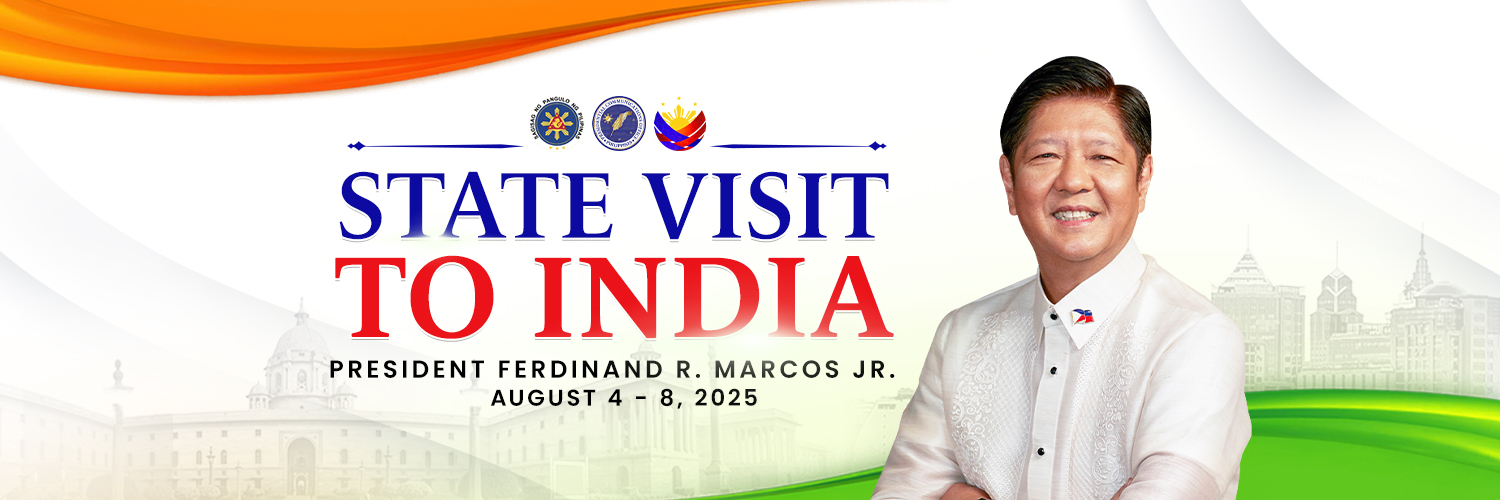Thank you Special Assistant on Investment and Economic Affairs, Secretary Frederick Go; the Trade and Industry Secretary Maria Cristina Roque; the other members of the cabinet; — I think the— of all the trips that I have taken abroad, this is the trip where we have the largest number of cabinet members that have accompanied. [Applause]
And this has been— and this, I think, is a very clear manifestation of how seriously we are committed to developing the ties between India and the Philippines at every single level; and the reason, number one, that it goes to show that the entire government is ready and willing, and keen [applause] to continue in our relationship; and the number of Cabinet Secretaries also indicates the number, the many, the multitude of areas in which we feel in the Philippines that we can tie up.
So let me introduce the rest. You’ve a — this is Secretary Deck Go who introduced me. He is the Special Assistant on Investment to the President. His job is to listen to your complaints and to fix them.[Laughters]
Together with him is our DTI Secretary, the Secretary of the Department of Trade and Industry, Cris Roque [applause] and she is a big champion of MSMEs, which is something that both Indian and the Philippine economies very much depend on; and she’s a great champion of the MSMEs because she actually grew a very small business into a multi-million-peso business. That is why I put her there because she knows, she understands what are the difficulties for small businesses to thrive. And I think she has been very, very enthusiastic in the terms of finding ways to help our little businesses and to connect them, not only to their locality, but through digitalization to the rest of the world.
Also, with us is the Secretary of the Department of Finance, Ralph Recto. [Applause] He is here obviously to oversee as he is the architect of our policies, especially when it comes to the planning the expenditures of our government and I think he is here to see — instead of worrying about the uses of cash, he is now here to see the sources of cash. So, that is why we brought him along. [Applause]
Sitting next to him is our Secretary Henry Aguda of the Department of Information and Communications Technology, definitely he is here because in recognition of the leading role that India place in the digital space, the remarkable growth in terms not only, in terms of businesses, in terms of capability, but also, in terms of the share of the market, and we thought that considering that this is considered the ‘Silicon Valley” of India, it is imperative that Henry come with us.
Also with us is the Secretary from the Department of Health, Secretary Ted Herbosa [applause]. We are trying to apply the lessons learned that we have to go through during the pandemic and there are many areas to that, and that we are building up our hospital system; we are building up our health insurance system; and also we are hoping to benefit from the experience of the Indian pharma industry that once again has taken a leading role when it comes to generic medicines and it is something that is part of the revitalization or rather the restructuring of our healthcare system. It is impossible to bring the cost without our own source of pharmaceuticals. And we are very very optimistic that we will find many many ways that we can partner.
And of course, always with us is our Secretary of the Department of Foreign Affairs [applause], who will look forward to easing the way for all of these activities that we are hoping to undertake in the very near future.
Our partners in this forum, the Federation of Indian Chambers of Commerce and Industry and the Philippine Chamber of Commerce and Industry; the friends and business partners from Philippines and India; ladies and gentlemen, good afternoon.
It is a profound pleasure and a distinct privilege to join you here in Bengaluru for the Philippine–India Business Forum.
This gathering stands as a testament to our enduring and dynamic partnership, marking a new and exciting chapter in the economic collaboration between the Philippines and India.
I am deeply grateful for your presence and your engagement here with us today. Your commitment signals the strength of our bilateral relationship and the even greater potential that lies ahead.
Our ties are built not only on shared economic aspirations, but also on a deep connection that spans culture and friendship that solidifies our alliance.
Just as Filipinos have come to appreciate the rich tapestry of Indian cinema and the profound wisdom of yoga, I am certain that many Indians have discovered the warmth of the Filipino hospitality and the beauty of our islands. These people-to-people connections are the true essence of thesepartnerships.
India’s ascent as a global economic powerhouse is truly inspiring — projected to reach USD 4.2 trillion in GDP this year and continuing to grow as a formidable hub of innovation, scale, and entrepreneurship. We applaud your remarkable journey.
In the same spirit of resilience and reform, the Philippines has sustained its momentum.
We recorded a 5.7% GDP growth in last year, building on over a decade of consistent expansion.
Even amidst the challenging global environment, we remain one of Southeast Asia’s most dynamic economies — driven by strong domestic demand, sound fundamentals, and a renewed commitment to competitiveness.
Our digital economy is projected to exceed USD 40 billion by 2030, a testament to this forward-looking vision that we have adapted. Our young, skilled, English-speaking workforce continues to attract global investment, making us a preferred destination for talent.
And our policy direction is very clear: to make the Philippines a trusted, connected, and competitive node in the Indo-Pacific economy.
This is the spirit of our administration’s Bagong Pilipinas vision — a new Philippines that enables innovation, drives inclusive growth, and welcomes partners who share our aspirations for prosperity and for progress.
To realize this vision, we are laying a strong foundation for long-term, high-quality investment.
We have vigorously pursued critical structural reforms that make the Philippines a more attractive and more reliable destination for capital, for technology, and for talent.
To our esteemed Indian partners, I want to assure you that the Philippine government stands ready to embrace your investments with open arms and with continuing and unwavering support.
These include:
The CREATE MORE Act, which is an amendment to an old law but it now streamlines and expands our fiscal incentives system and extends a maximum availment for strategic investments up to 27 years, ensuring long-term stability for your ventures;
There are the Green Lanes now for Strategic Investments, which institutionalizes green lanes to fasttrack the approval of priority investments, dismantling bureaucratic barriers and making it easier to do business;
Also the Public-Private Partnership Code, it provides a modern framework to scale transformative infrastructure and service delivery, paving the way for collaborative development across our archipelago; and
The Enterprise-Based Education and Training Law or EBET as we refer to, which ensures that ourworkforce development remains aligned with the
evolving needs of industry and of innovation, and guaranteeing a skilled talent pool for your operations.
Together, these measures reflect a comprehensive agenda — one that is geared toward enhancing competitiveness, ensuring sustainability, and building future-readiness.
We are continuously finding ways to make the Philippines an even more conducive place to do business.
This morning, the members of the Cabinet highlighted the complementarities between India and the Philippines across several sectors such as IT, and digital services, healthcare as well.
So, allow me to build on that message — not by restating these connections, but by emphasizing the greater value that our convergence can create for the region.
We believe that the Philippines and India are not merely aligned in sectors — we are aligned in strategic purpose, poised to lead together. Consider these powerful synergies:
In semiconductors and advanced electronics, India’s move up the value chain in design and R&D aligns naturally with the Philippines’ proven strengths in backend manufacturing, testing, and assembly. So, together, let us co-create resilient and regionally integrated value chains that are secure, that are scalable, and that are sustainable.
In pharmaceuticals and healthcare, India’s status as the world’s leading supplier
of generics and vaccines can power a new wave of health cooperation, anchored on access, affordability, and innovation across Asia, ensuring better health outcomes for millions.
On energy transition, our partnership can help shape the region’s clean energy future. Together, letus develop integrated renewable infrastructure, scalable storage solutions, and green manufacturing ecosystems, leading the charge towards a sustainable tomorrow.
In digital capability, the synergy is undeniable: India’s technological depth and the Philippines’ trusted role in global customer experience and IT-BPM delivery make us ideal partners for next-generation digital solutions — whether in fintech, health tech, logistics, AI-enabled services, during this 21st century it is the driving force.
These are not just transactional partnerships. They are robust pillars of shared prosperity. Together, we can share and then shape regional norms, deepen supply chain resilience, and lead in inclusive innovation.
We are also opening new avenues for investment in areas where India is demonstrating global leadership and where the Philippines is strategically positioned to contribute.
These include smart manufacturing, green metals, mineral processing, data center infrastructure, shipbuilding and maritime services.
In each of these sectors, we envision joint ventures and technical collaboration that build enduring industrial capabilities.
We have identified six priority sectors for long-term collaboration. These include electric vehicles, advanced electronics, renewable energy, high-tech agriculture, healthcare, and cybersecurity.
In each of these, we see strong alignment with Indian industry’s global footprint and tremendous potential for shared success.
So, as we strengthen our investment linkages, we are also looking to deepen our trade framework. The Philippines is ready to begin formal discussions on a Philippines–India Preferential Trade Agreement — a crucial tool that we believe can enhance two-way trade, encourage product diversification, and support modern supply chain integration.
Trade policy is not just a facilitative mechanism —it is a clear signal of trust. And we are prepared to move forward with India on that basis with confidence and a shared vision for prosperity.
Ladies and gentlemen,
What we are building here is not just another bilateral program. It is a powerful platform for long-term strategic convergence — one that recognizes our strengths, aligns our ambitions, and delivers tangible results for our people.
So, let’s move forward, let’s do it with confidence, with resolve, and with a spirit of camaraderie.
Let us seize this moment to make bold, future-ready decisions.
Let us demonstrate that when India and the Philippines work together, we do not just exchange goods. We build prosperity, we transfer knowledge, and we lead with purpose.
To all our partners here today: We are ready. We can Make It Happen — together.
Thank you very much.
Dhanyavaad. [Applause]

